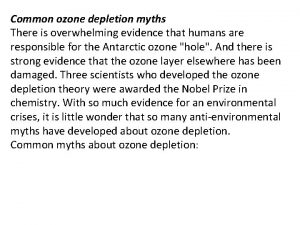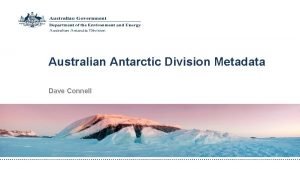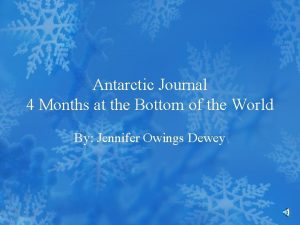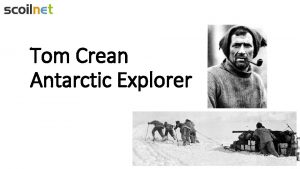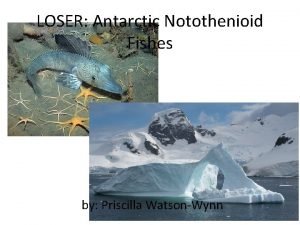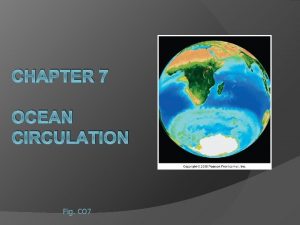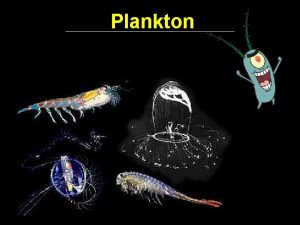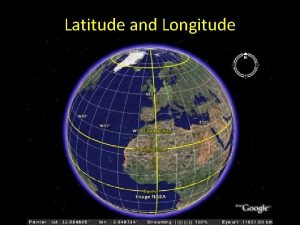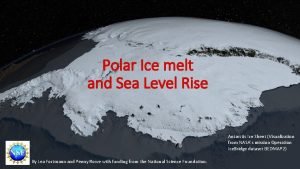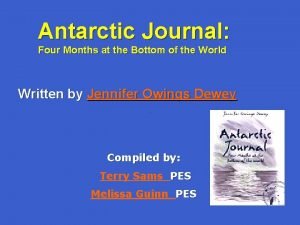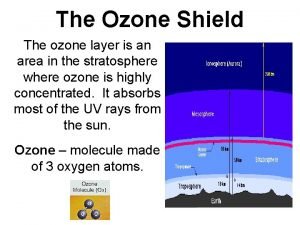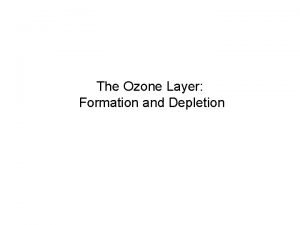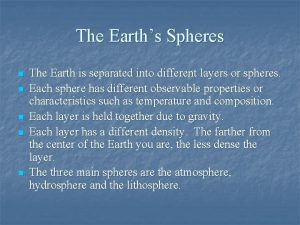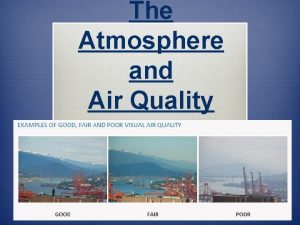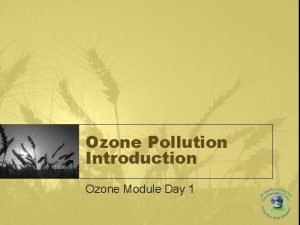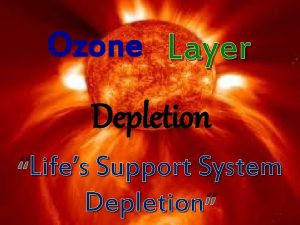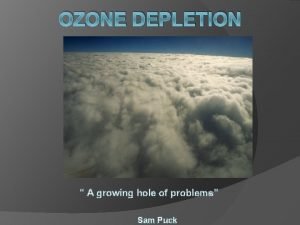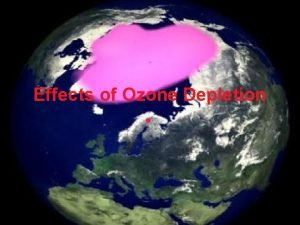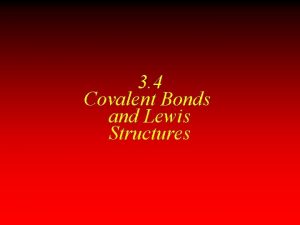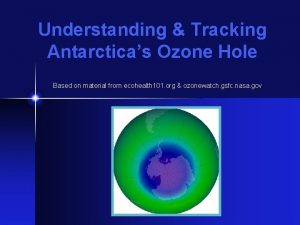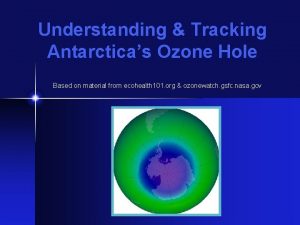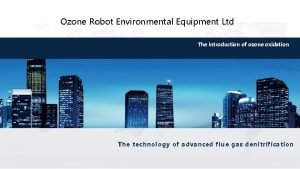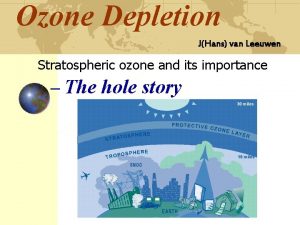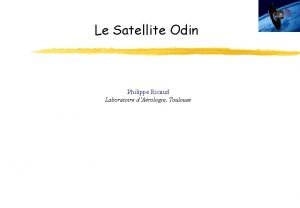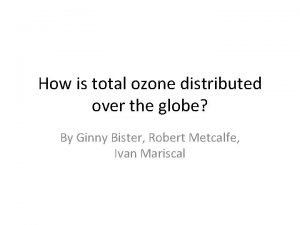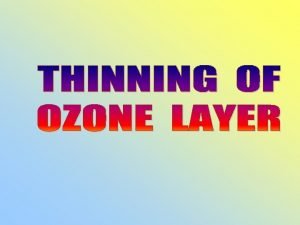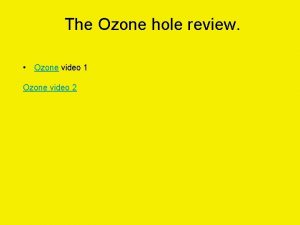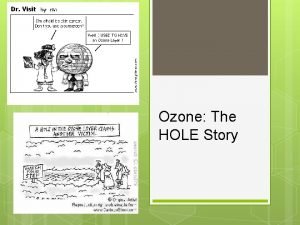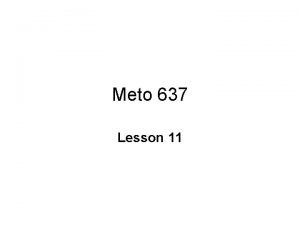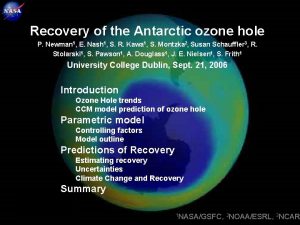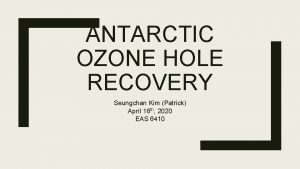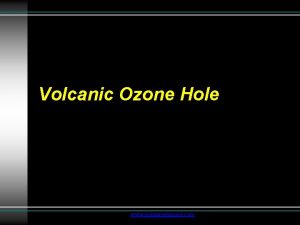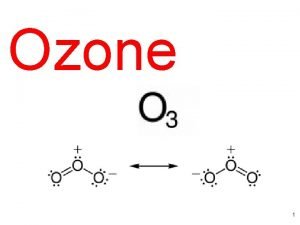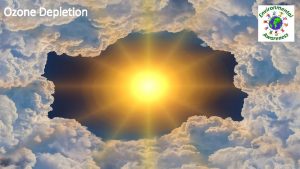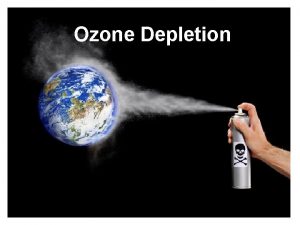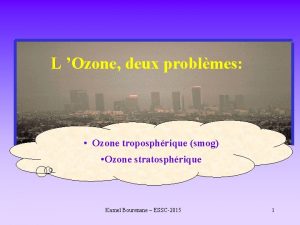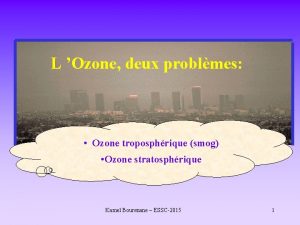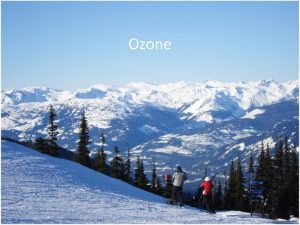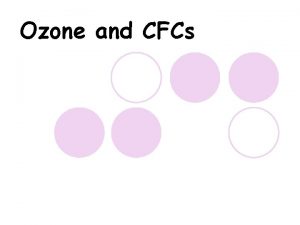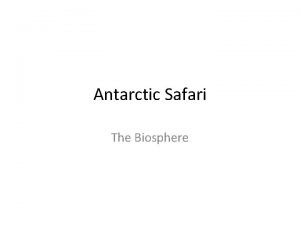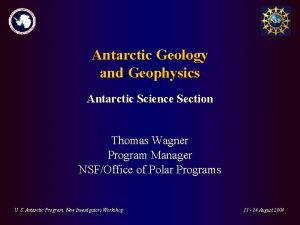Antarctic Ozone Hole Review 2012 Craig S Long





































- Slides: 37

Antarctic Ozone “Hole” Review 2012 Craig S. Long 1 Larry Flynn 2, Bryan Johnson 3 NOAA 1 -NWS/NCEP/Climate Prediction Center 2 -NESDIS/STAR/Satellite Meteorology & Climatology Division 3 -OAR/ESRL/Global Monitoring Division

Outline • Quick ozone review – Ozone generation cycle – Ozone depletion cycles • Ozone recovery expectations • NOAA-centric perspective • 2012 ozone “hole” in context of 32 previous years – Various ways to monitor and measure ozone “hole” • Meteorological conditions accountable for 2012 ozone size and longevity

Ozone “Life” Cycle

Ozone Destruction Cycle From 2010 Ozone Assessment

Reservoir molecules De. Nitrification Activation

Why Ozone Holes form over Antarctica and Not the Arctic From 2010 Ozone Assessment

Ozone Recovery Protocols From 2010 Ozone Assessment

Ozone Recovery Expectations From 2010 Ozone Assessment

Ozone Recovery Expectations From 2010 Ozone Assessment

2012 Antarctic Ozone “Hole” • Ozone “Hole” definition: • Area in which total column ozone is less than 220 DU • Satellite Perspective • South Pole Perspective

Suomi-NPP OMPS Total Ozone

Ozone “Hole” Time Series

Ozone “Hole” Annual Maximum Size Using SBUV/2 v 8 analyses

Ozone “Hole” Annual Mean Size Late Sept

Ozone “Hole” Monthly Mean

Monthly Mean Ozone Analysis

South Pole Ozonesonde Measurements Comparison of 2012 with 2006 which had near complete ozone depletion

South Pole Ozonesonde Measurements

South Pole Ozonesonde Measurements

South Pole Ozonesonde Measurements

South Pole Spectrophotometer Measurements Late October By late October the break down of the polar vortex lead to the early end of the 2012 ozone “hole” resulting in anomalously high total ozone values.

Meteorological Conditions • PSC Area – Defines the potential size of ozone depleted air • Vortex Area – Separates cold/ozone depleted polar air from ozone rich warmer mid-latitude air – Defines longevity of ozone hole • What modulates these: – Wave activity and heat flux from mid-latitudes

Area of PSC Temps and Polar Vortex

Vortex, Temperature, Ozone Relationship Note how the high ozone values coincide with the warm temperatures surrounding the polar vortex. Note how the polar vortex separates the ozone rich middle latitudes from the depleted ozone values inside.

SH Polar Temperatues 50 h. Pa SH high latitude temperatures were warm than last year and near the long term average during the SH winter/spring months. The temps raise rapidly in October due to the early vortex breakdown. 2 h. Pa SH high latitude temperatures were consistently warm during the SH winter/spring months.

Volume of Cold Air 2006 2012 Compared to a year (2006) with a large ozone hole, the PSC area at various levels in 2012 were much smaller.

Comparison of 2012 PSC Area with Previous Years Zonal Mean Temperature Anomaly

SH Poleward Heat Flux Heat flux activity showed several pulses in 2012 which raised temperatures and decreased the size of the PSC area/volume. The strong pulse in mid October lead to the vortex breakdown and filling in of the ozone hole.

50 h. Pa Temperature Jul/Aug 100 mb Heat Flux vs Aug/Sep 50 mb Temps 2012 Heat Flux [v’T’] (deg m sec-1)

50 h. Pa Temperature Comparison of Heat Flux/Temp Relationship between MERRA and CFSR Heat Flux [v’T’] (deg m sec-1)

Heat Flux Impacts on Polar Temperatures Wave 1 and 2 activity transports heat towards polar region. Increases the temperature in the polar vortex. Shrinks the area of PSCs.

Role of QBO Descending easterlies

Descending Easterlies BD Circulation Speeds Up High Polar Ozone Low Tropical Ozone High Polar Ozone

Descending cold anom

Low Ozone in Tropics, High in Extra-tropics and South Polar Region

SP August Ozone Levels are well above mean

Summary • • • SH Polar temperatures were warm Heat Flux activity was great PSC area was small Ozone Hole size is extremely small Wave activity and temperatures don’t necessarily explain why the ozone hole size was so small. • South Pole ozonesondes imply ozone levels were well above normal. • Perhaps ozone depletion was equivalent to other years yet due to higher starting point the area below 240 DU threshold was smaller than those same years. • Strong wave activity in Oct resulted in early end of ozone hole
 Ozone hole myth
Ozone hole myth Short short short long long long short short short
Short short short long long long short short short Once upon a time there lived an old woman
Once upon a time there lived an old woman Antarctic pearlwort
Antarctic pearlwort Australian antarctic data centre
Australian antarctic data centre Journeys antarctic journal comprehension test
Journeys antarctic journal comprehension test Explore with tom
Explore with tom Nototheniods
Nototheniods Cool antarctica.com
Cool antarctica.com Antarctic circumpolar current
Antarctic circumpolar current Planktons
Planktons Lines of latitude run from
Lines of latitude run from Antarctic expedition
Antarctic expedition Antarctic toothfish price
Antarctic toothfish price Antarctic journal four months at the bottom of the world
Antarctic journal four months at the bottom of the world Effect of ozone depletion on plants
Effect of ozone depletion on plants How do cfcs destroy ozone
How do cfcs destroy ozone Protective ozone layer
Protective ozone layer Ozone composition
Ozone composition Sopmed training
Sopmed training Atmega44
Atmega44 Protective ozone layer
Protective ozone layer Ozone layer depletion
Ozone layer depletion Ozone layer facts
Ozone layer facts Ozone blanket
Ozone blanket Cn- lewis structure
Cn- lewis structure Ozone hazard symbol
Ozone hazard symbol Ozone depletion effect on humans
Ozone depletion effect on humans Nh4 + molecular geometry
Nh4 + molecular geometry Ncnh2 lewis structure
Ncnh2 lewis structure Causes of the ozone depletion
Causes of the ozone depletion Ozone layer depletion introduction
Ozone layer depletion introduction Ozone robot
Ozone robot Stratospheric ozone depletion
Stratospheric ozone depletion Philippe odin
Philippe odin How is total ozone distributed over the globe
How is total ozone distributed over the globe Jamoytius
Jamoytius Ozone layer made up of
Ozone layer made up of
